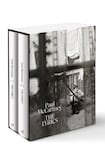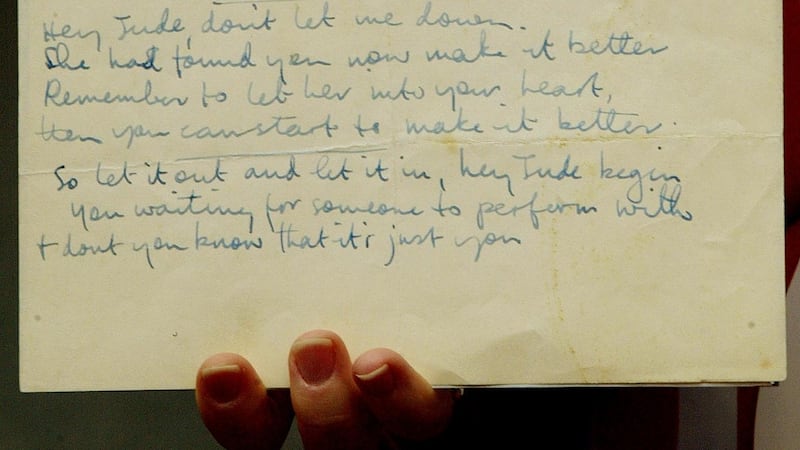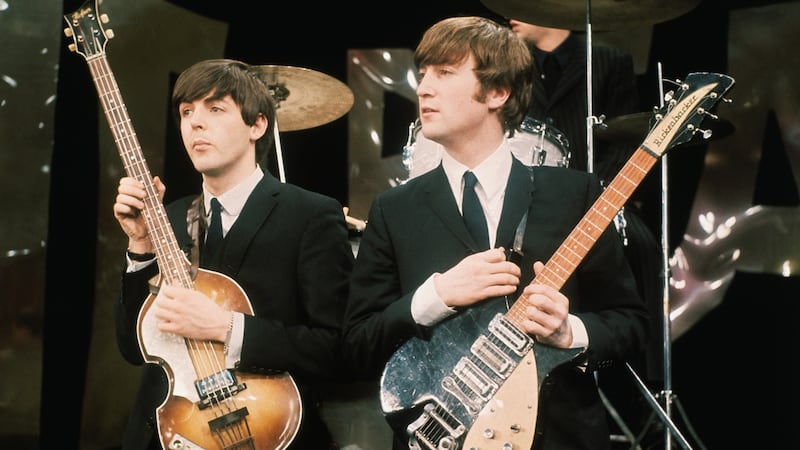
Last year in early March, the week before Ireland went into lockdown, I was in Liverpool with a morning to kill. So I went on a Beatles taxi tour.
At Penny Lane the driver stopped the taxi. We got out and, holding the lyrics on a laminated sheet, he went through the song line by line and pointed out everything – almost literally everything – to me.
We were standing outside the “barber showing photographs”; we were a few doors down from the bank where “the banker with the motorcar” worked. The “shelter in the middle of the roundabout” was a bus terminal, where McCartney changed buses on his way home from school. I was standing in the middle of McCartney’s raw material, moments of his childhood that he had converted into a three-minute masterpiece. It was a deeply moving, wonderful experience. I remember: both myself and the driver started laughing.
I'm not a Beatles die-hard, I'm not that keen on Sergeant Pepper, and I think "Ob-La-Di, Ob-La-Da" should probably be illegal
The lyrics of Penny Lane are in this book. Beside them is McCartney’s illuminating one-page commentary. John Lennon and himself often met at the bus terminal. He used the words “showing photographs” to suggest the idea that the barbershop was a gallery – “There’s an exhibition in his window”. Dylan Thomas’s Under Milk Wood was a big influence, as was his old English school teacher, Alan Durband, and his lesson on “free indirect speech”. He vividly remembers “the pretty nurse” who sold the “poppies from a tray”, on Remembrance Day. Some American listeners thought she was selling puppies, a new, unintended image – “a tray full of puppies”.

On the following two pages we’re given “Paul and John’s hand-written lyrics”. I spent time trying to find Lennon’s handwriting in there with McCartney’s. I wondered about the layout of some of the lines and flicked back to the printed lyrics, to compare them, and I realised – fully realised – 54 years after I first listened to the song, just how poetically and narratively important the three words “and meanwhile back” are.
The two pages following the handwritten lyrics feature stills from the promotional film and McCartney’s recording notes, which include my favourite two words from the entire 874-page book: “Trumpet bit”.
I hope it is becoming clear that there is a lot more to The Lyrics than the lyrics. Describing it as a book doesn’t quite capture the object. It is two books, two separate volumes, in a gorgeous box. It weighs 8kg on my bathroom scales. It’s a big thing of great beauty, and going back and forth through it is a hugely satisfying experience.
Paul Muldoon is the book’s editor, and he’s done a great job – because after his introduction there is no obvious trace of him. He explains how the book came about, out of recorded conversations between himself and McCartney, the first of which took place in New York in August 2015 and the final one in August 2020. There were 24 meetings, “two or three hours of intensive conversation”. They discussed six to eight songs each time they met. Muldoon had the conversations professionally transcribed, then edited McCartney’s words into “a semi-seamless narrative”.

It does feel seamless, never mind semi-. The lyrics and McCartney’s commentaries are presented in alphabetical order, not chronologically, and no matter where you start, or continue, at, say, Mrs Vandebilt (Pg.494) or All My Loving (Pg.2), McCartney seems to be waiting, ready to continue his warm, vivid, erudite stroll through his life and lyrics. I was reminded of the structure of Bob Dylan’s memoir, Chronicles: Volume One.
The autobiography is incomplete but the life – McCartney’s – seems more believable when examined in these glimpses. There is modesty hiding in the book’s bulk, and raw, gentle honesty. As McCartney himself states in his foreword: “Fans or readers, or even critics, who really want to learn more about my life should read my lyrics, which might reveal more than any single book about The Beatles could do.”
I’m not a Beatles die-hard, I’m not that keen on Sergeant Pepper, and I think “Ob-La-Di, Ob-La-Da” should probably be illegal. But I loved reading McCartney’s account of its composition, where the title phrase came from, why he chose a “trolley” as Desmond’s mode of transport instead of a “tram”, how Lennon and himself were trying to write songs “that had a very conversational tone”, and how, still, he is “very much switched on to the power of the ordinary”.
I read All My Loving and saw two glorious boys, facing each other as they sing, earnest but grinning, as they set off into the world to make their dead mothers proud
There are 154 sets of lyrics in this book, and it’s almost impossible to read most of them without hearing the melodies and trumpet bits. But it is well worth trying. Read, not heard, Lady Madonna – a song I love – is a different experience. I read it and thought of Zola’s best novels. “Lady Madonna, children at your feet.” McCartney writes: “The fact that my mother Mary died when I was fourteen is something I never got over.” A great song has, somehow, become even greater.
The first song in the collection is All My Loving. I came to it after With a Little Help from My Friends, which McCartney and Lennon had tailored especially for Ringo’s voice; and Hey Jude – McCartney’s commentary on this one is worth a review of its own, or a TV series. I wasn’t expecting much of All My Loving, but I loved reading the words. They’re so simple and clever, and exuberant.
Elsewhere in the book, McCartney acknowledges that the partnership – “the interplay” as Muldoon describes it – between himself and Lennon was “nothing short of miraculous”, and he describes how they “wrote with two guitars”. “The joy of that was that I was left-handed and [John] was right-handed, so I was looking in a mirror and he was looking in a mirror.”
I read All My Loving and saw two glorious boys, facing each other as they sing, earnest but grinning, as they set off into the world to make their dead mothers proud.










